Abstract
Objective
To assess the level and accuracy of understanding of human papillomavirus (HPV) infection among female public health personnel in Chonbuk province.
Methods
Nine hundred ninety-one female public health personnel were asked to complete a questionnaire assessing HPV awareness and specific knowledge about the virus. The questionnaire contained 11 demographic informations and nine true-false questions on knowledge about HPV infection.
Results
Questionnaires were completed by 546 women, of whom 145 (37.6%) had heard of HPV. Married women (P=0.019), those with a history of candida, genital warts (P<0.001), or an abnormal smear result (P=0.001), annually visitor for a Pap smear (P=0.023) were more likely to have heard of human papilloma virus. Medical doctor (38.6%) was the most common source of hearing of HPV. Overall percentage of knowledge among those who had heard of HPV was 56.3%. Responses indicated than more than 70% had up-to-date knowledge about several issues: HPV is the main cause of cervical cancer, HPV is sexually transmitted, The pill protects against HPV, and Men can carry HPV. Fewer than 50% knowledge of HPV infection were as follows: HPV viruses are divided to low-risk and high-risk type, HPV infections persist forever, condoms protect against HPV.
Figures and Tables
References
1. Denny-Smith T, Bairan A, Page MC. A survey of female nursing students' knowledge, health beliefs, perceptions of risk, and risk behaviors regarding human papillomavirus and cervical cancer. J Am Acad Nurse Pract. 2006. 18:62–69.
2. Koutsky L. Epidemiology of genital human papillomavirus infection. Am J Med. 1997. 102:3–8.
3. Genital HPV infection-CDC fact sheet. Centers for Disease Control and Prevention [Internet]. 2009. update 2009 Nov 24; cited 2010 Mar 10. Atlanta, GA: Available from:
http://www.cdc.gov/std/HPV/STDFact-HPV.htm.
4. National Cancer Information Center (Korea) [Internet]. 2007. update 2009 Dec 28; cited 2010 Mar 10. Goyang: National Cancer Information Center (Korea);Available form:
http://www.cancer.go.kr/cms/statics/stat/index.html.
5. Lowy DR, Frazer IH. Chapter 16: Prophylactic human papillomavirus vaccines. J Natl Cancer Inst Monogr. 2003. (31):111–116.
6. Lorincz AT, Richart RM. Human papillomavirus DNA testing as an adjunct to cytology in cervical screening programs. Arch Pathol Lab Med. 2003. 127:959–968.
7. Bosch FX, Manos MM, Munoz N, Sherman M, Jansen AM, Peto J, et al. Prevalence of human papillomavirus in cervical cancer: a worldwide perspective. International biological study on cervical cancer (IBSCC) Study Group. J Natl Cancer Inst. 1995. 87:796–802.
8. Lambert EC. College students' knowledge of human papillomavirus and effectiveness of a brief educational intervention. J Am Board Fam Pract. 2001. 14:178–183.
9. D'Urso J, Thompson-Robinson M, Chandler S. HPV knowledge and behaviors of black college students at a historically black university. J Am Coll Health. 2007. 56:159–163.
10. Holcomb B, Bailey JM, Crawford K, Ruffin MTt. Adults' knowledge and behaviors related to human papillomavirus infection. J Am Board Fam Pract. 2004. 17:26–31.
11. Jain N, Irwin KL, Montano D, Kasprzyk D, Carlin L, Freeman C, et al. Family physicians' knowledge of genital human papillomavirus (HPV) infection and HPV-related conditions, United States, 2004. Fam Med. 2006. 38:483–489.
12. Waller J, McCaffery K, Forrest S, Szarewski A, Cadman L, Wardle J. Awareness of human papillomavirus among women attending a well woman clinic. Sex Transm Infect. 2003. 79:320–322.
13. Vail-Smith K, White DM. Risk level, knowledge, and preventive behavior for human papillomaviruses among sexually active college women. J Am Coll Health. 1992. 40:227–230.
14. Han YJ, Lee SR, Kang EJ, Kim MK, Kim NH, Kim HJ, et al. Knowledge regarding cervical cancer, human papillomavirus and future acceptance of vaccination among girls in their late teens in Korea. Korean J Obstet Gynecol. 2007. 50:1090–1099.
15. Choi KA, Kim JH, Lee KS, Oh JK, Liu SN, Shin HR. Knowledge of human papillomavirus infection and acceptability of vaccination among adult women in Korea. Korean J Obstet Gynecol. 2008. 51:617–623.
16. Quality guidelines of cervical cancer screening. National Cancer Information Center (Korea) [Internet]. 2008. update 2009 July 20; cited 2010 Mar10. Goyang: National Cancer Information Center (Korea);Available form:
http://www.cancer.go.kr/cms/dataedudata/1245251_1619.html.




 PDF
PDF ePub
ePub Citation
Citation Print
Print





 XML Download
XML Download